This article forms part of a series created by the UIAA – International Mountaineering & Climbing Federation – for International Mountain Day, 11 December. An overview article about the UIAA & IMD can be found here.
For IMD, project leaders from UIAA Mountain Protection Award showcased projects have provided information on the progress of their projects, the importance of biodiversity – the theme of this year’s IMD – and the impact of Covid-19.
Save The Barun
Organisation: Barun Biomeridian Research Project (Barun Bachaon Taskforce)
Location: Nepal
MPA edition(s): 2018
The goal of the BBRP, Barun Bachaon (“Save the Barun”) project is to build an ecosystem and bolster community resilience in Nepal’s Barun Valley. This valley features what is considered to be the most pristine ecosystem in the whole of the Himalaya, extending from the arctic-like triple-summit massif (Everest, Lhotse and Makalu) down through alpine, temperate, and subtropical ecologies into biological tropics. The Barun Bachaon, The East Foundation (TEF) and Local Coordinating Committee unites village leaders, conservation experts and DNPWC, National Park officials to promote mountain protection in an area that is home to Earth’s highest peaks and high-adventure destinations.
Progress Report since 2018
BBRP is a project of Future Generations University in partnership with the East Foundation local NGO (please view the links at www.Future.Org and www.Future.Edu).
The Makalu-Barun National Park protects the eastern half of the Mt Everest massif, a large region that remains almost a pure natural environment. Barun Valley is the most pristine valley in Nepal. The Park was initiated by Future Generations University President Dr Daniel Taylor, internationally recognised for giving a definitive explanation for the Yeti. The Nepal government and authorities in Tibet/China and India have cooperated with Future Generations and began to work with national parks throughout the Himalaya.
One important facet about these national parks is that they are community-based; indeed they are the first community based national parks in the world and founded on UNESCO bioreserve concepts. Further information is detailed here.

“I started working twenty five years ago on the community-based aspects,” explains Nawang Singh Gurung, Barun Biomeridian Research Project Coordinator, “and have since worked on both the Tibet/China and Nepal sides of Mount Everest. BBRP, Barun Bachoan has also grown another project called Songs of Adaptation (which links to the UN’s Sustainable Goals 4, 7, 8, 11, 13, 15, 16, and 17). This is using the Barun Valley and recordings of birds to monitor climate change. With warmer climates, it seems trees are growing at higher climes. Birds travel with them. Sound recordings of bird songs document this. Sophisticated artificial intelligence programming that our university has specially developed (supported by the Microsoft AI for Earth programme) is monitoring this change. It is very exciting and important to be able to measure climate change in this way.”
BBRP on biodiversity
How and why is preserving biodiversity a key part of your project?
As we know biodiversity is shrinking globally and losing its balance due to population growth, overuse of natural resources by people, and human conflict with wildlife. Biodiversity has played a great role in creating the planet we live in and helping improve people’s lives. The main threats to biodiversity are habitat loss due to cutting forests and shifting cultivation alters the natural habitat. The question is how to maintains the balance of biodiversity in an ecosystem to keep it functioning?
What specific impact has Covid-19 had on your project?
We have had one specific issue due to Covid-19, donors stopped funding or decreased funding. This left us unable to conduct training and specific programmes. Staff were not able to visit the field. There has also been a significant impact on the labour market, tourism and local communities. We would encourage the UIAA community to help support our project. (Donations to MPA projects can be made through the UIAA’s donate page).
Information courtesy of Nawang Singh Gurung, BBRP, Barun Bachaon Research Project Coordinator
Other profiled projects include:
Patagonia Waste Management, Argentina
Study and Monitoring of Chachacomani Glacier, Bolivia
John Muir Trust, UK
SWAT Project, Pakistan
FURTHER READING
The UIAA has also recently commenced a series profiling past Mountain Protection Award winners. Following recent profiles on the progress made by Mountain Wilderness France (2016) and AlpineLearning Project Weeks (2019) – the recent focus turned to 2017 winner Mount Everest Biogas Project (MEBP).
PROJECT PARTNER
Bally is a Swiss luxury brand established in 1851, with a rich heritage in shoemaking, and a longstanding relationship to architecture, arts and the environment. Today, the brand offers unique designs across shoes, accessories and ready-to-wear, driven by a dedication to craftsmanship and a contemporary aesthetic. Bally has over 300 retail stores and 500 multi-brand points of sale that span across 66 countries worldwide, including a global e-commerce platform serving 34 countries. For more information, please visit Bally.com




